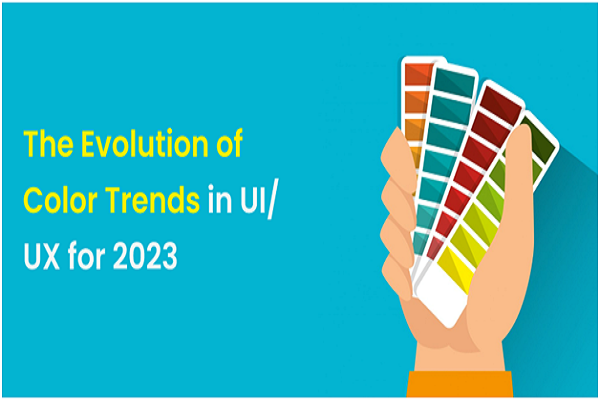Color is a fundamental element in UI/UX design, influencing user perception and engagement. As we venture into 2023, the ever-evolving world of design brings forth new color trends that shape the digital landscape.
Studying a UI UX Certification Course offers the advantage of staying updated with color trends in UI/UX for 2023. This knowledge ensures that your designs are contemporary and visually appealing, enhancing user experiences. It also demonstrates your commitment to professional growth, making you a valuable asset in the field.
In this blog, we'll explore the latest color trends in UI/UX for 2023, shedding light on their significance and potential impact on the user experience.
Vibrant and Playful Color Palettes
The year 2023 welcomes a shift towards more vibrant and playful color palettes in UI/UX design. Designers are embracing bold, saturated colors to inject energy and personality into interfaces. Vibrant hues evoke emotions and create a memorable user experience, making them ideal for brands that seek to stand out and captivate their audience.
These lively colors are often used for call-to-action buttons, notifications, and highlights. The trend encourages creativity and sets a dynamic tone for digital products, signaling a break from the traditional, muted color schemes of the past.
Soft and Natural Color Tones
Conversely, alongside vibrant colors, soft and natural color tones are gaining prominence in 2023. These colors mimic nature's palette, creating a calming and harmonious user experience. Soft pastels and earthy shades help reduce visual stress and promote a sense of balance, making them suitable for wellness, health, and mindfulness applications.
Designers use these tones to create tranquil backgrounds, evoke a sense of authenticity, and add a touch of elegance to the UI. The combination of vibrant and soft colors can create striking visual contrasts that draw users' attention to essential elements while maintaining overall harmony.
Dark and Moody Themes
Dark mode and moody themes continue to be a significant trend in UI/UX design for 2023. Dark backgrounds with contrasting elements offer a visually appealing and energy-efficient alternative to traditional light themes. These designs are not only stylish but also easy on the eyes, particularly in low-light environments.
Dark themes are popular across various platforms, including social media, mobile apps, and websites. They provide a modern, high-end look while enhancing the visibility of content and interactive elements. This trend reflects the growing demand for user customization and improved accessibility.
Gradient and Duotone Effects
Gradient and duotone effects are here to stay in 2023. Gradients provide a smooth transition of colors, adding depth and dimension to UI elements. This dynamic effect can create a sense of movement and evoke emotions, making it an excellent choice for UI components like headers, buttons, and backgrounds.
Duotone effects involve the use of two contrasting colors to create a striking visual impact. This technique is often used in image overlays, making photos and graphics more visually appealing and cohesive with the overall design.
Both gradients and duotone effects are versatile tools for UI/UX designers to experiment with and infuse creativity into their work.
Accessibility and Inclusivity
In 2023, the design community is increasingly focused on accessibility and inclusivity. This trend reflects the importance of making digital experiences available and enjoyable for everyone, regardless of their abilities or preferences.
Colors play a pivotal role in creating accessible designs. The use of high-contrast color combinations and text that meets accessibility standards (e.g., WCAG guidelines) ensures that all users can comfortably navigate the interface. It's essential to consider not only aesthetic appeal but also usability, particularly for those with visual impairments.
Retro and Nostalgic Palettes
The nostalgia trend in UI/UX design is making a strong comeback in 2023. Designers are turning to retro color palettes, reminiscent of the '80s and '90s, to invoke feelings of nostalgia and familiarity. This trend can establish a strong emotional connection with users, making them feel comfortable and engaged.
Retro color palettes often feature bold and unconventional color combinations, neon hues, and gradients. They work well for brands that want to create a sense of nostalgia or target specific age groups with a fondness for these eras.
Adaptive Color Schemes
Adaptive color schemes are a practical trend that takes user preferences and context into account. In 2023, UI/UX designers are incorporating features that allow users to customize the interface's color scheme. This personalization enhances the user experience, making digital products feel tailored to individual preferences.
Adaptive color schemes, responsive to the user's surroundings or time, enhance visibility in different lighting. This trend aims to improve user comfort and engagement, prioritizing their experience by ensuring that the interface is visually accommodating, whether it's bright daylight or a cozy evening.
Minimalistic and Monochromatic Designs
In 2023, minimalistic design remains popular, emphasizing simplicity and clarity. It uses monochromatic colors, reducing distractions and helping users focus on content. This design style offers a clean and uncluttered interface, enhancing the user's experience by prioritizing content over excessive ornamentation.
Monochromatic designs primarily use a single color or a range of shades from a single hue, creating a clean, elegant, and timeless look. This approach emphasizes the importance of content and functionality, making it a popular choice for websites, apps, and interfaces that prioritize usability over visual extravagance.
Conclusion
In the ever-evolving world of UI/UX design, color trends for 2023 are diverse, catering to a wide range of user preferences and brand identities. The use of vibrant and playful palettes, soft and natural tones, dark and moody themes, gradients, duotone effects, accessibility and inclusivity, retro palettes, adaptive color schemes, and minimalistic designs all contribute to the ongoing evolution of user interfaces.
The choice of color in UI/UX design extends far beyond aesthetics; it influences user perception, mood, and accessibility. As designers continue to explore and experiment with these trends, the ultimate goal remains to enhance the user experience, making digital products not only visually appealing but also functional and user-centric. Staying updated with these trends ensures that your designs remain relevant and engaging in the dynamic world of UI/UX.

No comments:
Post a Comment